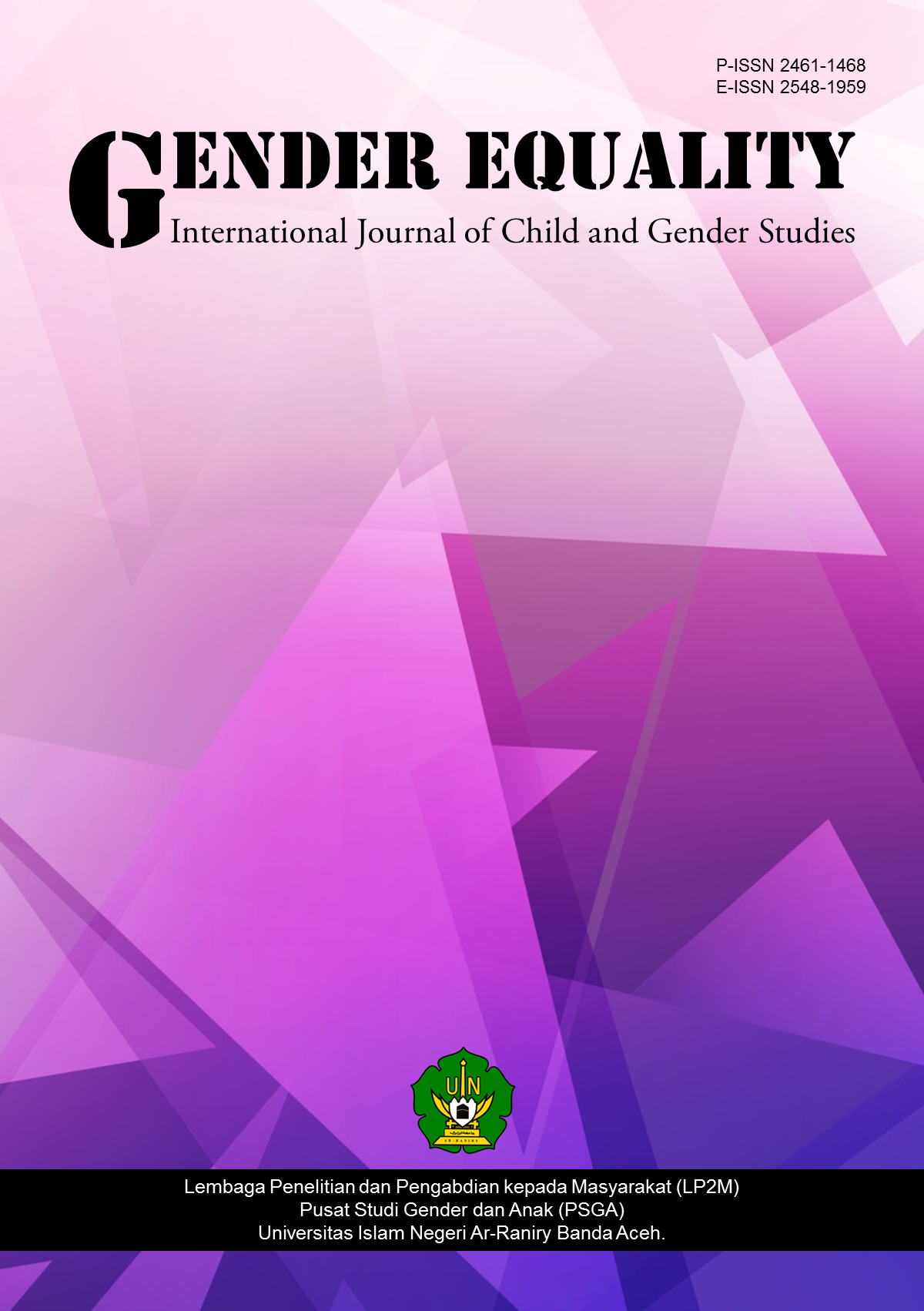Community's role in preventing child marriage: An analysis of models and community compliance with village policies
DOI:
https://doi.org/10.22373/equality.v9i2.19673Keywords:
Community, Child, Child Marriage, Policy.Abstract
The presence of regulations that regulate the increase in the age of children fails to prevent child marriage. However, the existence of a community with an adequate child protection system has been able to prevent child marriage. This study aims to analyse the model developed by the community and the background to the emergence of community initiatives in efforts to prevent child marriage. The research method used in this study is a qualitative research method with a descriptive approach. Data was obtained by interviewing Reje Kampung, community facilitators, and NGO program officers. The research was conducted in Bener Meriah Regency. Data analysis was carried out qualitatively by selecting relevant data and then describing it systematically. The results showed that the model for preventing child marriage was carried out by forming a Cadre of Friends of Women and Children (SAPA), which is responsible for disseminating child protection issues. Second, establish a children's forum at the gampong level as a pioneer and reporter for child protection that continues to report on any incidents that affect children. Third, formulate regulations and policies in the village as guidelines for the community. The emergence of a child marriage prevention community was due to support from PKPM Aceh on the basis of support from UNICEF, which strengthened the issue of child protection from the roots (community) from 2022–2023. The community is strengthened by the issue of child protection and trains SAPA Cadres as the spearhead of fulfilling the rights of women and children in the village.
References
Annual Report of the Syar'iyah Court of Simpang Tiga Redelong, 2021-2022.
Anon. n.d.-a. “Interview with Firdaus D. Nyak Idin, Specialist Child Protection PKPM , 29 Juni 2023.”
Anon. n.d.-b. “Interview with Hasanuddin, Kepala Desa, 26 Mei 2023.”
Anon. n.d.-b. “Interview with Ihsan, Program Oficcer PKPM, 20 Juni 2023.”
(Anon. n.d.-d) “Interview with Suci Indah Lestari, Facilitator Komunitas Perlindungan Anak, 26 Mei 2023.”
(Anon. n.d.-e) “Interview with Suci Indah Lestari, Facilitator Komunitas Perlindungan Anak, 27 Mei 2023.”
(Anon. n.d.-f) “Interview with Fakhurddin, Facilitator Daerah Perlindungan Anak, 27 Mei 2023.”
Saraswati, R. (2015). Child protection law in Indonesia (No. 2). PT. Image Aditya Bakti.
Candra, M. (2018). Aspek perlindungan anak Indonesia analisis tentang perkawinan di bawah umur. Kencana.
Fadli. (2021). Implikasi yuridis terhadap penerbitan kartu keluarga bagi pasangan nikah siri di Indonesia. Mediasi: Media Ilmu Syari Jurnal Dan Ahwal Al Syakhsiyah, 4(1), 82-91.
Julijanto, M., & Hayatuddin, A. K. (2016). Dampak perceraian dan pemberdayaan keluarga studi kasus di Kabupaten Wonogiri. 1, 55–77.
Mansari & Rizkal. (2021). Peranan hakim dalam upaya pencegahan perkawinan anak: antara kemaslahatan kemudharatan. El-Usrah: Jurnal Hukum Keluarga, 4(2), 328–356.
Mustaqim, A., & Chasanah, I. (2022). Keterlibatan Laki-Laki dalam Pencegahan Perkawinan Anak: Studi Pada Komunitas Gerakan Laki-laki Peduli Perempuan dan Anak. Prosiding Konferensi Gender dan Gerakan Sosial, 1(01), 450-460.
Nurjanah, S. (2018). Keberpihakan Hukum Islam Terhadap Perlindungan Anak. Al-’Adalah, 14(2), 391-432. https://doi.org/10.24042/adalah.v14i2.2905
Rahmatillah, S., & Bustamam, A. (2023). Government’s legal policy on the protection of women and children pre- and post-illegal marriages. Gender Equality: International Journal of Child and Gender Studies, 9(1), 98-109. https://doi.org/10.22373/equality.v9i1.16124
Saraswati, R. (2015). Hukum perlindungan anak di Indonesia. PT. Citra Aditya Bakti.
Sekarayu, S. Y., & Nurwati, N. (2021). Dampak pernikahan usia dini terhadap kesehatan reproduksi. Jurnal Penelitian dan Pengabdian Kepada Masyarakat (JPPM), 2(1), 37-45.
Sugiarti, T. K. T. (2021). Implementasi dan impikasi pernikahan dini. Jurnal Legal Reasoning, 4(1), 81–95.
Ulfiyati, N. S. (2019). Pandangan dan peran tokoh kongres ulama perempuan Indonesia (KUPI) dalam mencegah perkawinan anak. De Jure: Jurnal Hukum Dan Syar’iah, 11(1), 23–35. https://doi.org/10.18860/j-fsh.v11i1.6488
Wicaksono, K. W. (2019). Keterlibatan komunitas (community engagement) dalam pembangunan di tingkat desa. Jurnal Manajemen Pelayanan Publik, 3(1), 1-12.
Mansari, M., Fatahillah, Z., Muzakir, M., Oslami, A. F., & Zainuddin, M. (2020). Concretization of urgent reason and sufficient evidence in providing marriage dispensation for children by the judge. Nurani: Jurnal Kajian Syari'ah dan Masyarakat, 20(2), 195-206.
Zamharira, C., Irma, A., & Jamilah, J. (2022). The role of South Aceh Regency Women’s Empowerment Office for Child Protection and Family Planning (DP3AKB) in preventing underage marriage. Gender Equality: International Journal of Child and Gender Studies, 8(1), 86-97. https://doi.org/10.22373/equality.v8i1.12741.
Downloads
Published
Issue
Section
License
GENDER EQUALITY: International Journal of Child and Gender Studies allows the author(s) to hold the copyright and to retain the publishing rights without restrictions. Authors who publish with this journal agree to the following terms:
- Authors retain copyright and grant the journal right of first publication with the work simultaneously licensed under a Creative Commons Attribution License that allows others to share the work with an acknowledgment of the work's authorship and initial publication in this journal.
- Authors are able to enter into separate, additional contractual arrangements for the non-exclusive distribution of the journal's published version of the work (e.g., post it to an institutional repository or publish it in a book), with an acknowledgment of its initial publication in this journal.
- Authors are permitted and encouraged to post their work online (e.g., in institutional repositories or on their website) prior to and during the submission process, as it can lead to productive exchanges, as well as earlier and greater citation of published work.



